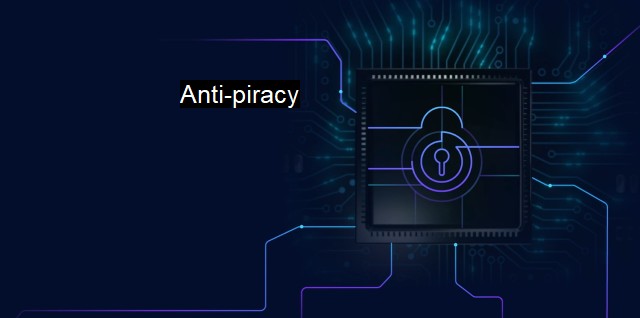What is Anti-piracy?
The Importance of Anti-Piracy in Promoting Cybersecurity and Antivirus Protection: A Comprehensive Explanation of Key Features and Software
"Anti-piracy" refers to a set of measures and frameworks designed to prevent and combat the unlawful use, distribution, and reproduction of copyrighted or protected content. Examples of such content include software, videos, music, and written content. In the context of cybersecurity and antivirus applications, anti-piracy measures play a critical role in protecting intellectual property rights and preventing the spread of malware.When it comes to software, anti-piracy concerns are paramount as the development and distribution of computer programs involve significant investment of resources. Piracy of software involves the unauthorized copying or distribution of copyrighted software. It is a pervasive issue globally as it essentially means stealing someone else's intellectual property. When others can freely or cheaply obtain what was expensive to produce, it siphons the economic value generated by the product. Beyond the economic impact, the problem is also deeply rooted within cybersecurity itself.
This is particularly relevant considering that pirated copies of software can contain hazardous malware and other threats that pose serious risks to system security, including damaging systems and accessing sensitive information. Many corners of the internet where pirated software primarily propagates are full of such perilous pitfalls. These pirated versions of software often lack key defense mechanisms against malicious software, leaving computers and networks vulnerable to virus attacks and other threats.
Anti-piracy tools come in several types and are designed to work on various levels. They range from countermeasures built into the software code itself to external mechanisms like digital rights management (DRM). Examples of anti-piracy measures include product activation mechanisms, which allow the program to run only on a specific machine, and regular updates, which makes older, illegal copies of the software obsolete.
One of the key differences between authorized and pirated software is access to updates, particularly security updates. Authorized users have priority access to patches and are protected from known security issues. In contrast, pirates are left exposed with outdated versions, which in general, do not have up-to-date security features against the latest threats.
Companies often employ real-time internet-based checks for software license validity. These checks verify that the user's copy of the software is legitimate and that it has not been installed on more machines than the provided license allows. Consequently, authorities can identify where and when unauthorized usage happens.
Many anti-piracy measures in cybersecurity also involve legislative action, including implementing stringent laws against intellectual property violations, particularly on a global scale. This area also comprises attention on international trade agreements to negotiate policies on intellectual property rights enforcement to combat piracy effectively.
Various preventative measures are taken within the industry to promote anti-piracy. Hacker-proof codes, trail versions of software, end-user license agreements (EULA), open-source software, licensing, online activation of software, holography, encrypted registration numbers, and frequent online updating and so on, are all strategies software manufacturers use to ensure their product's anti-piracy mechanisms.
Anti-piracy serves to protect not only the copyright holder and their revenues but also the end user. Encouraging the use of legitimate copyrighted products through education, product pricing strategies, and legislation aids in preventing and combatting piracy. Individuals and businesses using legal software gain the benefit of keeping their systems and data more secure with anti-piracy measures. In cybersecurity landscape, anti-piracy certainly is a significant aspect that helps keep infringing activities at bay, safeguards intellectual property, and strengthens the antivirus defenses, altogether shape a safer cyberspace.

Anti-piracy FAQs
What is anti-piracy?
Anti-piracy refers to the measures taken to prevent the unauthorized distribution or illegal copying of copyrighted materials such as software, music, videos, and other digital content.Why is anti-piracy important in cybersecurity?
Anti-piracy measures help protect digital content from being stolen or hacked, which could result in great financial losses for the content creators, publishers, and distributors. Moreover, piracy can introduce malware and other security threats to users' computers, networks, and systems.What are some common anti-piracy methods?
Common anti-piracy methods include using digital rights management (DRM) technologies to encrypt and control access to digital content, tracking and monitoring online sharing and distribution of copyrighted materials, sending cease-and-desist letters to pirates or employing legal actions against them, and educating users about the dangers and consequences of piracy.What should individuals do to respect anti-piracy laws?
Individuals should refrain from downloading or sharing copyrighted materials without proper authorization or licensing. They should purchase or use legal copies of software, music, videos, and other digital content, and support the rightful owners or creators of these works. Individuals should also make sure their computers and devices are protected by reliable antivirus and anti-malware software and avoid visiting suspicious or illegal websites that may contain pirated or malicious content.| | A | | | B | | | C | | | D | | | E | | | F | | | G | | | H | | | I | | | J | | | K | | | L | | | M | |
| | N | | | O | | | P | | | Q | | | R | | | S | | | T | | | U | | | V | | | W | | | X | | | Y | | | Z | |
| | 1 | | | 2 | | | 3 | | | 4 | | | 7 | | | 8 | | |||||||